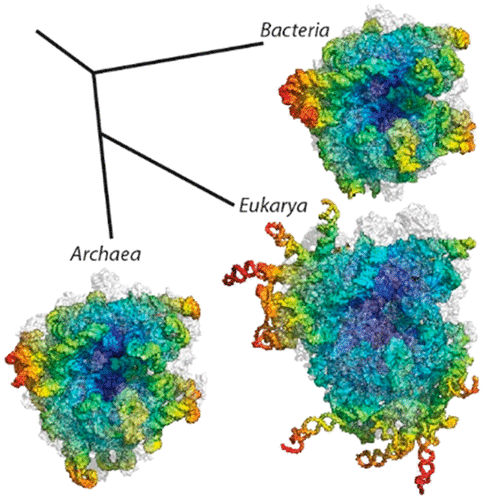当前位置:
X-MOL 学术
›
Chem. Rev.
›
论文详情
Our official English website, www.x-mol.net, welcomes your
feedback! (Note: you will need to create a separate account there.)
Root of the Tree: The Significance, Evolution, and Origins of the Ribosome.
Chemical Reviews ( IF 51.4 ) Pub Date : 2020-05-06 , DOI: 10.1021/acs.chemrev.9b00742 Jessica C Bowman 1 , Anton S Petrov 1 , Moran Frenkel-Pinter 1 , Petar I Penev 1 , Loren Dean Williams 1
Chemical Reviews ( IF 51.4 ) Pub Date : 2020-05-06 , DOI: 10.1021/acs.chemrev.9b00742 Jessica C Bowman 1 , Anton S Petrov 1 , Moran Frenkel-Pinter 1 , Petar I Penev 1 , Loren Dean Williams 1
Affiliation

|
The ribosome is an ancient molecular fossil that provides a telescope to the origins of life. Made from RNA and protein, the ribosome translates mRNA to coded protein in all living systems. Universality, economy, centrality and antiquity are ingrained in translation. The translation machinery dominates the set of genes that are shared as orthologues across the tree of life. The lineage of the translation system defines the universal tree of life. The function of a ribosome is to build ribosomes; to accomplish this task, ribosomes make ribosomal proteins, polymerases, enzymes, and signaling proteins. Every coded protein ever produced by life on Earth has passed through the exit tunnel, which is the birth canal of biology. During the root phase of the tree of life, before the last common ancestor of life (LUCA), exit tunnel evolution is dominant and unremitting. Protein folding coevolved with evolution of the exit tunnel. The ribosome shows that protein folding initiated with intrinsic disorder, supported through a short, primitive exit tunnel. Folding progressed to thermodynamically stable β-structures and then to kinetically trapped α-structures. The latter were enabled by a long, mature exit tunnel that partially offset the general thermodynamic tendency of all polypeptides to form β-sheets. RNA chaperoned the evolution of protein folding from the very beginning. The universal common core of the ribosome, with a mass of nearly 2 million Daltons, was finalized by LUCA. The ribosome entered stasis after LUCA and remained in that state for billions of years. Bacterial ribosomes never left stasis. Archaeal ribosomes have remained near stasis, except for the superphylum Asgard, which has accreted rRNA post LUCA. Eukaryotic ribosomes in some lineages appear to be logarithmically accreting rRNA over the last billion years. Ribosomal expansion in Asgard and Eukarya has been incremental and iterative, without substantial remodeling of pre-existing basal structures. The ribosome preserves information on its history.
中文翻译:

树的根:核糖体的意义,演变和起源。
核糖体是一种古老的分子化石,为生命的起源提供了望远镜。核糖体由RNA和蛋白质制成,可在所有生命系统中将mRNA转换为编码蛋白质。普遍性,经济性,中心性和古代在翻译中根深蒂固。翻译机制主导着整个生命树中作为直向同源物共享的基因集。翻译系统的世系定义了通用的生命之树。核糖体的功能是构建核糖体。为了完成这一任务,核糖体产生了核糖体蛋白,聚合酶,酶和信号蛋白。地球上生命所产生的每种编码蛋白质都已通过出口通道,该通道是生物学的诞生渠道。在生命树的根部阶段,在生命的最后共同祖先(LUCA)之前,出口隧道的发展是主导和不懈的。蛋白质折叠与出口通道的演化共同发展。核糖体表明蛋白质折叠是由内在的紊乱引发的,并通过一个短而原始的出口通道得到支持。折叠发展为热力学稳定的β结构,然后发展为动力学捕获的α结构。后者是通过长而成熟的出口通道实现的,该通道部分抵消了所有多肽形成β-折叠的一般热力学趋势。RNA从一开始就陪伴着蛋白质折叠的进化。LUCA最终确定了核糖体的通用共有核,其质量接近200万道尔顿。核糖体在LUCA后进入停滞状态,并保持数十亿年。细菌核糖体从不停滞。古细菌核糖体仍处于淤滞状态,除了多余的Asgard,它已在LUCA后分泌rRNA。在过去的十亿年中,某些谱系的真核核糖体似乎在对数地分泌rRNA。在Asgard和Eukarya的核糖体扩展是增量的和迭代的,而没有对现有的基础结构进行实质性的重塑。核糖体保留有关其历史的信息。
更新日期:2020-05-06
中文翻译:

树的根:核糖体的意义,演变和起源。
核糖体是一种古老的分子化石,为生命的起源提供了望远镜。核糖体由RNA和蛋白质制成,可在所有生命系统中将mRNA转换为编码蛋白质。普遍性,经济性,中心性和古代在翻译中根深蒂固。翻译机制主导着整个生命树中作为直向同源物共享的基因集。翻译系统的世系定义了通用的生命之树。核糖体的功能是构建核糖体。为了完成这一任务,核糖体产生了核糖体蛋白,聚合酶,酶和信号蛋白。地球上生命所产生的每种编码蛋白质都已通过出口通道,该通道是生物学的诞生渠道。在生命树的根部阶段,在生命的最后共同祖先(LUCA)之前,出口隧道的发展是主导和不懈的。蛋白质折叠与出口通道的演化共同发展。核糖体表明蛋白质折叠是由内在的紊乱引发的,并通过一个短而原始的出口通道得到支持。折叠发展为热力学稳定的β结构,然后发展为动力学捕获的α结构。后者是通过长而成熟的出口通道实现的,该通道部分抵消了所有多肽形成β-折叠的一般热力学趋势。RNA从一开始就陪伴着蛋白质折叠的进化。LUCA最终确定了核糖体的通用共有核,其质量接近200万道尔顿。核糖体在LUCA后进入停滞状态,并保持数十亿年。细菌核糖体从不停滞。古细菌核糖体仍处于淤滞状态,除了多余的Asgard,它已在LUCA后分泌rRNA。在过去的十亿年中,某些谱系的真核核糖体似乎在对数地分泌rRNA。在Asgard和Eukarya的核糖体扩展是增量的和迭代的,而没有对现有的基础结构进行实质性的重塑。核糖体保留有关其历史的信息。











































 京公网安备 11010802027423号
京公网安备 11010802027423号